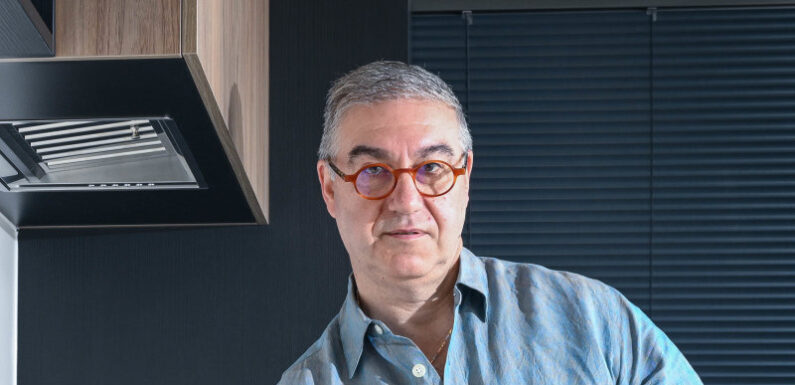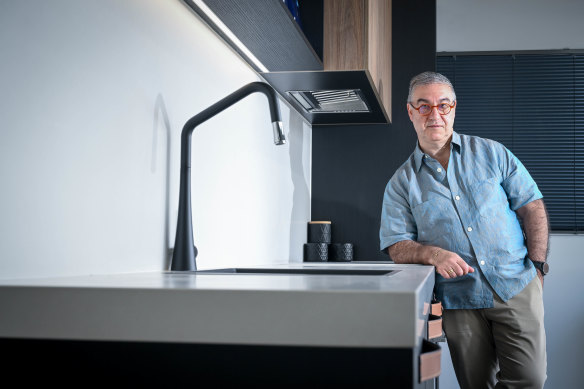
Save articles for later
Add articles to your saved list and come back to them any time.
Health experts are divided on whether engineered stone benchtops can be safely modified or removed from hundreds of thousands of homes, with one suggesting they should be left alone for years until the risks from lower levels of exposure are properly known.
Last week’s announcement of a national ban on the use, supply and manufacture of the product commonly used in shiny kitchen benchtops has sparked questions from builders, interior renovators and health groups about the slabs already installed across the country; many likened it to the legacy of asbestos.
Mint Kitchens owner Frank Iaria leaning against an engineered stone bench in his Moonee Ponds showroom.Credit: Eddie Jim
The popularity of engineered stone is behind a surge in silicosis inflicting stonemasons with irreversible lung disease, but while the nation’s workplace safety ministers have now deemed it too risky for tradies to cut, health experts are assuring property owners the substance is safe in their homes.
However, thoracic physician Deborah Yates, who has campaigned against its use, urged “maximum precaution” when renovating a home with the slabs in place, warning it was better to hold off until there was sufficient data available about what even lower silica dust exposure could do.
“In about two or three years, we’ll probably have more information about whether people who are exposed to really low levels are harmed,” Yates said, adding that the crisis was identified by doctors only seeing the worst cases first.
“We saw the tip of the mountain, but we weren’t able to find out about the bottom of the mountain until such time as the waters recede.”
The Lung Foundation’s senior manager for occupation lung disease, Elizabeth Early, also recommended a waiting period, saying it was possible for tradesmen to develop silicosis after days or months of cutting engineered stone.
But Dr Graeme Edwards, a member of the former dust diseases taskforce, said it wasn’t necessary to wait until more data was available, and that it would be extremely rare for someone to develop conditions from a short period of exposure.
Associate Professor Sonja Klebe, from the College of Medicine and Public Health at Flinders University, said similar measures to asbestos removal could be used, whereby specialists donned respirators and hazmat suits. However, she said she wasn’t aware of anyone who had contracted silicosis from once-off exposure.
“Once-off removal activity would not be expected to cause significant disease. We don’t have the data to say its safe, but we don’t have the data to say we shouldn’t do it either,” Klebe said.
Federal, state and territory ministers agreed on Wednesday to commission Safe Work Australia to come up with a framework by March for the safe handling of engineered stone when renovating.
Frank Iaria, owner of Melbourne kitchen design company Mint Kitchens, said the ban raised questions about who would be qualified to handle the slabs during modification and removals, adding that Victoria already had a licensing regime set up for fabricators.
“I’d just relate it back to the asbestos … we have to treat it different to every other job,” he said.
Master Builders Australia CEO Denita Wawn said builders remained concerned about legal uncertainties and unanswered questions regarding their contractual obligations, as well as alternative products, and implications for businesses with existing stocks.
“We stress the importance of taking a national, risk-managed approach to managing in-situ engineered stone to minimise confusion and complexity that ultimately compromises safety outcomes,” she said.
A spokesperson for Caesarstone, a major manufacturer of engineered stone, said the company had consistently advocated for a nationwide licensing scheme for anyone handling any stone containing crystalline silica, “backed by rigorous enforcement” by work health and safety bodies.
“As all stone containing crystalline silica must be handled the same way to avoid the risk of silicosis, under this approach there would be no need for a separate licensing scheme for the handling of legacy installed stone,” the spokesperson said.
Earlier this year, the government legislated the creation of an occupational dust diseases registry to record prevalence of respiratory diseases and develop practices to reduce exposure to workers, but health experts have been critical of a lack of consultation and the limitations of the proposed model.
Yates said the registry would be crucial to providing data on how engineered stone could be safely removed, but it was not yet up and running, and the government still had a lot of work to do on the scope and mechanics of the register, including what should be measured.
Assistant Health Minister Ged Kearney said: “The registry will help identify the industries, occupations, job tasks and workplaces at risk and use targeted early intervention and prevention activities to reduce worker exposure and disease.”
Professor Hubertus Jersmann, a director of the Thoracic Society of Australia and New Zealand, said he feared that “in the whole publicity rush”, replacement products were being rushed into the country to appease the industry without what he believed was proper oversight.
“The big mistake about this stone is it came into the country without proper testing. We’re about to do this again,” he said.
Start the day with a summary of the day’s most important and interesting stories, analysis and insights. Sign up for our Morning Edition newsletter.
Most Viewed in Politics
From our partners
Source: Read Full Article
